Short-term lets: consultation annexes
Research annexes to supplement the short-term lets consultation paper on a regulatory framework for Scotland.
The Short-Term Rental Sector in Scotland
Self-catering Accommodation in Scotland
Self-catering accommodation provides a key supply of tourist accommodation in Scotland. Estimates from Scotland's Visitor Survey 2015 showed that just under one quarter of all tourists stayed in self-catering units (Frontline 2017).
Self-catering Properties across Scotland
The Association of Scotland's Self-Caterers (ASSC) commissioned Frontline to conduct research on the economic impact of short-term lettings on the Scottish economy (Frontline 2017). The research was conducted between July 2016 and March 2017 and used information from the Valuation Rolls of the Scottish Assessors Association, as well as Supercontrol booking records, an online survey of 669 visitors who used self-catering accommodation in Scotland during 2016, and additional data from 183 self-catering property owners. This analysis refers to traditional self-catering accommodation in Scotland and does not include sharing economy short-term letting via online platforms (Airbnb, HomeAway, HouseTrip, etc.), serviced apartments and apartment hotels (aparthotels).
The study found that, in 2016, there were around 16,160 self-catering properties in Scotland, with over half situated in the Highlands, followed by Fife, and Edinburgh and the Lothians (Table 1) (Frontline 2017).
Table 1 - Self-catering properties by VisitScotland region 2016
| VisitScotland region | No. of properties | % |
|---|---|---|
| The Highlands | 3,982 | 24.6 |
| The Kingdom of Fife | 2,356 | 14.6 |
| Edinburgh & The Lothians | 2,045 | 12.7 |
| Argyll & The Isles | 1,584 | 9.8 |
| Perthshire | 1,568 | 9.7 |
| Scottish Borders | 1,433 | 8.9 |
| Dumfries & Galloway | 964 | 6.0 |
| Loch Lomond, Trossachs, Stirling and Forth Valley | 746 | 4.6 |
| Greater Glasgow & The Clyde Valley | 394 | 2.4 |
| Outer Hebrides | 293 | 1.8 |
| Ayrshire & Arran | 268 | 1.7 |
| Aberdeen City and Shire | 260 | 1.6 |
| Shetland | 117 | 0.7 |
| Dundee & Angus | 101 | 0.6 |
| Orkney | 50 | 0.3 |
| Total | 16,161 | 100.0 |
Source: Frontline 2017 (p. 4), based on Scottish Assessors' Association 2016
As these figures are based on Scottish Assessors Association Rolls, they do not include properties that have not been assessed for business rates purposes, including, for example, some properties listed on Airbnb.
At town-level, the top 15 locations for self-catering businesses in 2016 are shown in Table 2. The majority of self-catering units were located in Edinburgh, significantly more properties than in any of the other locations.
Table 2 - Top 15 locations for self-catering in Scotland 2016
| Rank | Visitor locations | No. of properties |
|---|---|---|
| 1 | Edinburgh | 1351 |
| 2 | Isle of Arran | 369 |
| 3 | Isle of Skye (exc. Portree) | 360 |
| 4 | Isle of Mull | 345 |
| 5 | Inverness | 330 |
| 6 | Oban | 303 |
| 7 | North Berwick | 265 |
| 8 | Portree | 256 |
| 9 | Aberfeldy | 227 |
| 10 | Castle Douglas | 222 |
| 11 | Isle of Islay | 217 |
| 12= | Glasgow | 214 |
| 12= | Lairg | 214 |
| 14 | Newton Stewart | 213 |
| 15 | Aviemore | 186 |
Source: Frontline 2017, based on Scottish Assessors Association 2016 (p. 4)
Locations in Fife, where no town-by-town breakdown of properties was available, have been excluded.
Self-catering Operators
Frontline (Frontline 2018) conducted a survey of traditional self-caterers in Scotland (including 268 ASSC members and non-members). Some key findings of this survey can be summarised as follows (Frontline 2018, p. 8):
- 6 out of 10 self-caterers operated multiple properties;
- 42% operated in city centres or urban areas of Scotland;
- For 37% of the operators self-catering earnings were their sole income, while for 53% it was an additional income;
- 81% were subject to non-domestic rates, 9% to Council Tax and 10% to both;
- The most frequent routes to the market were operator's website (88%), word of mouth/repeat business (81%), group platform (76%), collaborative economy platform (67%), and social media (65%);
- The most frequent collaborative economy platforms used to advertise self-catering units were Airbnb (60%), Trip Advisor (55%), Holiday Lettings (41%), and Booking.com (41%);
- The time of usage of each advertising channel varied. Around 70% had used their own website or a group platform for over 5 years, while 34% had used a collaborative economy platform for over 5 years and 26% had used social media for over 5 years.
- The most frequent additional routes to the market were VisitScotland (88%) and EmbraceScotland (69%).
From the above findings, it is clear that traditional self-caterers use, together with their own websites, collaborative economy platforms to advertise their listings, highlighting a shift towards these types of accommodation platforms.
Bookings of Self-catering Accommodation
The Frontline study (Frontline 2017) analysed a database of 111,014 bookings made in 2016 using the website for self-catering Supercontrol. The bookings referred to a total of 1,928 unique properties, of which 52% were situated in the Highlands, Fife and Edinburgh and the Lothians (Frontline 2017, p. 5). Overall, almost 8 in 10 properties were in rural areas (76%), from which just under half were in remote rural Scotland (46%) (Frontline 2017, p. 6). Similarly, rural areas had the largest number of bookings (81%), from which just under half were made for remote rural areas. In detail, 26% of all bookings were made for the Highlands, followed by Argyll and the Isles (12%), Fife (11%), and Edinburgh and the Lothians (10%) (Frontline 2017, p. 8).
Almost all self-catering units had fewer than 5 bedrooms, with properties in urban areas being smaller than those in small towns and rural areas. Just over half of all properties had capacity for up to five guests (Frontline 2017, pp. 7-8). Most bookings were for up to six nights (71%), while 23% of the bookings were for a week and 6% for eight or more nights. More than 30% of the bookings were made for the summer months, i.e. between June and August. Edinburgh and the Lothians received the biggest number of bookings made by overseas visitors, followed by the Highlands (Frontline 2017, pp. 9-10).
VisitScotland data (VisitScotland 2017b) confirms that bookings for self-catering accommodation showed a pronounced seasonal difference especially in rural areas, such as the Highlands and Orkney (Figure 1). The regions including Edinburgh and Glasgow showed relatively stable occupancy rates across the year.
Figure 1 – Net unit occupancy rates (%) of self-catering accommodations in selected regions in each month - 2016
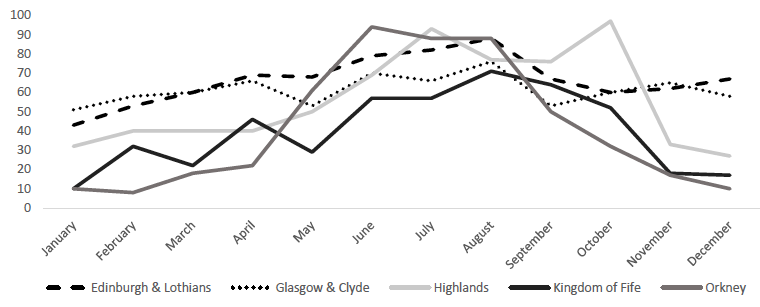
Source: Scottish Accommodation Occupancy Survey 2016. Data retrieved from Visit Scotland 2017b p. 21[2]
Self-catering Guests
As part of the research, Frontline (Frontline 2017) conducted a survey of 669 visitors who used self-catering accommodation in Scotland in 2016. Just over half of the visitors (52%) were from England, 36% from Scotland and just under 10% were overseas visitors (Frontline 2017, p. 13). Some 9 out of 10 visitors stayed for a week or less, from which 46% stayed for 7 nights. A further 2% stayed for 15 or more days (Frontline 2017, p. 17). Overseas visitors were more likely to travel in large groups (3 or more people), travel without children, stay for at least two weeks and visit during the summer months (Frontline 2017, p. 11).
Collaborative Economy Accommodation Platforms
In addition to traditional self-catering accommodation a range of collaborative platforms are now operating, offering tourist accommodation. Platforms acting for short-term lets include peer-to-peer and vacation rental platforms, as well as home swapping platforms, and represent the largest sector of the collaborative economy in Europe (Scottish Government 2018a).
According to a research report published in 2017 by Skift[3], the biggest peer-to-peer accommodation platforms with listings in Scotland (in November 2017) included:
- Airbnb: 21,900 active listings and 12,600 hosts in Scotland (between March 2016 and March 2017[4])
- Couchsurfing: 64,500 hosts in Scotland of which 11,000 in Edinburgh
- FlipKey: 7,000 listings in Scotland
- HouseTrip: 7,000 listings in Scotland
- HomeAway: 2,500 listings in Scotland
- Wimdu: under 1,000 listings in Scotland[5].
Indigo House (Indigo House 2017) noted that hosts and accommodation operators may advertise their listing(s) using more than one online platform, so there is a risk of double-counting listings.
Airbnb in Scotland
This section looks at Airbnb's activity in Scotland, as a representative of collaborative economy online accommodation platforms. It focuses on Airbnb for two reasons; firstly because of its dominating position among the peer-to-peer accommodation sector, and secondly because there are more publicly available data and reports on Airbnb activity compared to the activity of other similar platforms.
Airbnb has operated in Scotland since 2009 and is the largest peer-to-peer accommodation platform across the world. According to Airbnb, in 2017 the economic activity of Airbnb hosts and guests in Scotland was equal to £482.9 million (Airbnb 2018)[6]. VisitScotland estimated that Airbnb accounted for 5% of all tourism accommodation in 2016 (Scottish Government 2018a).
This section reviews reports published by Airbnb, academic findings, and research using data provided by intermediate agencies (Inside Airbnb and AirDNA), with the aim to drawing a general picture of Airbnb's activity in Scotland. It draws on information on the top destinations in Scotland for Airbnb guests, the number of Airbnb listings, type and length of accommodation provided by Airbnb, and information on hosts and guests.
The Open Data Institute (ODI), as part of the Institute's data innovation programme[7], studied the use of data on improving peer-to-peer accommodation[8] and concluded that even though there is a rich amount of data held by peer-to-peer accommodation platforms, access to these data is restricted (Open Data Institute 2018). Inside Airbnb[9] is an independent, non-commercial (open source) provider of data to explore how Airbnb is used around the world. AirDNA[10] is a market-based platform that tracks information on Airbnb listings by using publicly available data from the Airbnb website.
Airbnb disputes the accuracy of data scraped by Inside Airbnb and AirDNA. The Scottish Expert Advisory Panel on the Collaborative Economy pointed out "it is crucial that third party analysts focus on collaborating with platforms to access data at source, rather than relying on data-scraped information" (Scottish Government 2018a, p. 14). However, many academics and analysts use the scraped data to draw an overall image of Airbnb activity at national and regional level and argue that the outputs are accurate (Wachsmuth, Kerrigan et al. 2017). Caution is needed when drawing conclusions from scraped data analysis.
The focus of the section, besides Scotland, is on Edinburgh[11] for the following reasons. Firstly, it is the most visited destination in Scotland and receives the largest number of Airbnb guests. Secondly, it has the highest number of Airbnb listings, and finally, there is more research and evidence available about Airbnb activity in Edinburgh compared to other Scottish areas.
Top Airbnb Destinations in Scotland
The top 5 Airbnb destinations (as measured by number of guests) in Scotland in 2017 were: Edinburgh, Glasgow, Inverness, Isle of Skye, and Oban (Airbnb 2018). The top 15 destinations are shown in Table 3 along with other information about the listings and hosts.
Table 3 – Top Airbnb destination across Scotland in 2017/18
| City | Total guest arrivals | Number of nights a typical listing is booked | Total host earnings (£) | Total economic activity (£) | Earnings of typical host (£) | Number of active listings |
|---|---|---|---|---|---|---|
| Edinburgh | 640,000 | 41 | 61.6M | 238.7M | 4,300 | 10,500 |
| Glasgow | 160,000 | 66 | 12.7M | 57.9M | 4,100 | 2,700 |
| Inverness | 57,000 | 37 | 3.5M | 14.7M | 5,500 | 850 |
| Isle of Skye[12] | 49,600 | 79 | 3.8M | 14.5M | 8,900 | 550 |
| Oban | 25,900 | 44 | 1.7M | 7.3M | 6,100 | 360 |
| Aberdeen | 21,500 | 33 | 1.6M | 8.3M | 1,800 | 740 |
| Dundee | 16,200 | 31 | 1.3M | 6.1M | 3,000 | 440 |
| Kyle of Lochalsh | 16,200 | 74 | 1.3M | 4.5M | 3,000 | 440 |
| Stirling | 21,500 | 33 | 0.9M | 4M | 1,800 | 740 |
| Fort William | 28,900 | 57 | 1.8M | 7.2M | 7,800 | 330 |
| Aviemore | 10,100 | 65 | 0.8M | 3.7M | 8,100 | 150 |
| Ullapool | 9,900 | 53 | 0.5M | 2.3M | 4,800 | 170 |
| St Andrews | 9,500 | 39 | 1.1M | 3.5M | 4,900 | 240 |
| Elgin | 6,700 | 39 | 0.5M | 2.2M | 4,200 | 130 |
| Perth | 6,400 | 21 | 0.4M | 1.9M | 2,600 | 140 |
| Scotland | 1.4M | 44 | 113.4M | 482.9M | 3,800 | 25,200 |
Source: Retrieved from https://press.airbnb.com/airbnb-unveils-data-on-top-15-destinations-across-scotland-for-the-first-time-expands-experiences-on-airbnb-across-the-country/
The largest growth in the number of listings between July 2016 and July 2017, was seen in Highland (+81%), compared to a 43% increase for Edinburgh and a 45% increase for Glasgow (Table 4) (Airbnb 2017b).
Table 4 – Growth of Airbnb listings from 1st July 2016 – 1st July 2017
| County | Number of listings 01/07/2014 | Number of listings 01/07/2015 | Number of listings 01/07/2016 | Number of listings 01/07/2017 | Growth Year on Year 01/07 2016-2017 |
|---|---|---|---|---|---|
| Argyll and Bute | 100 | 270 | 640 | 920 | 44% |
| City of Edinburgh | 1,900 | 3,500 | 6,300 | 9,000 | 43% |
| Fife | 100 | 440 | 680 | 910 | 33% |
| Glasgow City | 1,000 | 1,100 | 1,500 | 2,200 | 45% |
| Highland | 280 | 690 | 1,700 | 3,100 | 81% |
Source: Retrieved from Airbnb 2017b, p. 5
Growth of Airbnb Listings
Scotland
According to Airbnb, between July 2016 and July 2017, there were 21,900 active Airbnb listings[13] in Scotland (Airbnb 2017c). Based on a 2018 Airbnb report, in 2018 there were 31,000 active listings in Scotland (Airbnb 2018b).
Figure 2 shows the growth in available (not necessarily new) Airbnb listings in Scotland between 2015 and 2017, using AirDNA data. There is an increase in the total number of Airbnb listings across Scotland of both entire homes and private rooms.
Figure 2 – The growth of Airbnb in Scotland – Total available listings 2015-2017
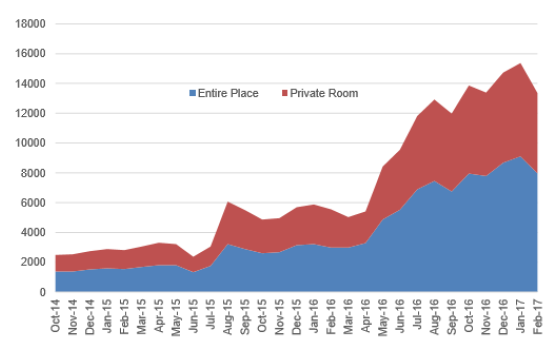
Source: Retrieved from Indigo House 2017, p. 26. Data sourced from AirDNA.
Edinburgh
Based on Inside Airbnb data (retrieved from their website), there has been a notable increase in the number of listings in Edinburgh, with a total increase of +100.5% between July 2016 and July 2018 (Table 5).
Table 5 – Number of Airbnb listings in Edinburgh 2016-2018
| Year | Listings | Change on year |
|---|---|---|
| July 2016 | 6,272 | |
| July 2017 | 9,189 | +46.5% |
| July 2018 | 12,578 | +37% |
Source: Inside Airbnb data
In November 2018, there were 11,985 Airbnb listings[14] in the City of Edinburgh (Inside Airbnb data 18 Nov. 2018[15]). Based on Airbnb reports, there were 10,500 listings in Edinburgh during 2017 (Airbnb 2018), while in 2015 there were 3,500 listings (Airbnb 2017b). In 2009, the first year of Airbnb in Edinburgh, there were 8 listings registered (SPICe 2019).
Figure 3, shows the growth in available (not necessarily new) Airbnb listings in Edinburgh between 2015 and 2017, and highlights that there is a growth in the total number of Airbnb listings across Edinburgh of both entire homes and private rooms.
Figure 3 – The growth of Airbnb in Edinburgh – Total available listings 2015-2017
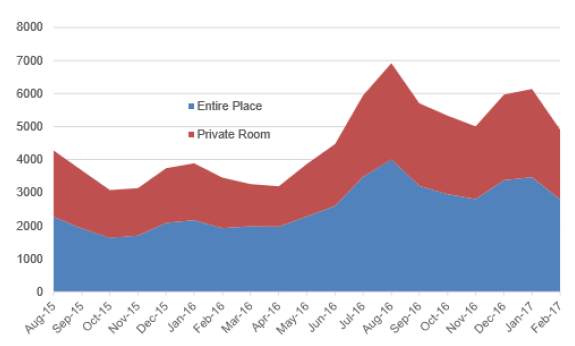
Source: Retrieved from Indigo House 2017, p. 27. Data sourced from AirDNA.
Location of Airbnb Listings
Edinburgh
Edinburgh in 2018 had approximately 240 listings for every 10,000 people living in the city (SPICe 2019). Airbnb listings are spread unevenly across Edinburgh. In 2016, the city centre together with Leith Walk had the largest number of listings (Rae 2017) and also of new listings (Figure 4) (Indigo House 2017). "In the City Centre ward, there is one Airbnb listing for every 11 residents, with comparable figures of 23 for Leith Walk, 37 for Meadows/Morningside and 34 for Leith" (Rae 2017, p. 4). The Edinburgh City Centre ward had around 13,000 dwellings in 2018, with just over 2,000 Airbnb entire property listings, which means a ratio of 1:6.5 of entire property listings to dwellings (Chartered Institute of Housing 2019). There was also neighbourhood-based diversity regarding the number of Airbnb listings, ranging from 674 listings in the 'Old Town, Princes Street and Leith Street' (over 10% of all listings) and 4 in 'Barnton, Cammo and Cramond South' (Rae 2017, p.6).
Figure 4 – Edinburgh Cluster Map of New Airbnb Listings (entire home/apt) in 2016
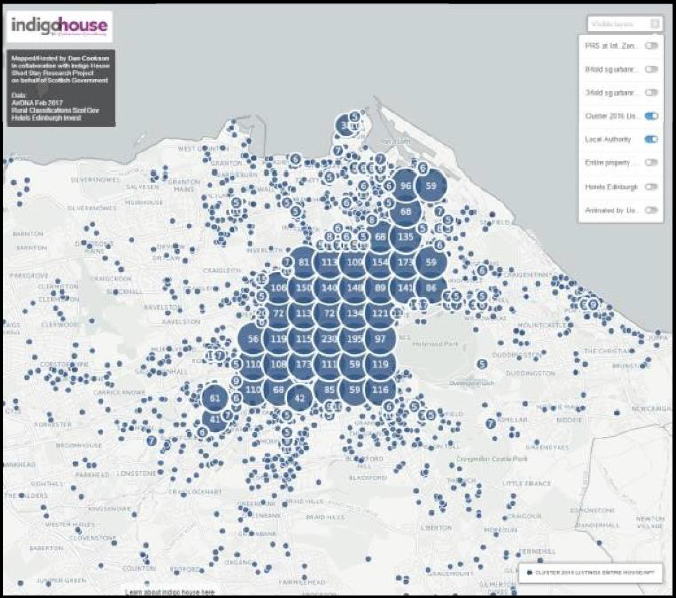
Source: Retrieved from Indigo House 2017, p. 21. Data sourced from AirDNA.
Figure 5 shows an Edinburgh map of the Airbnb listings (blue to red dots based on night price), the number of households that live within the private rented sector (PRS) (grey shading) and the number of Edinburgh hotels (yellow dots). Most of the red dots, which indicate the most expensive Airbnb listings, are located within the city centre (high PRS density) and very close to most of the hotels (Indigo House 2017). Areas with low density of PRS households (light grey) have very low or no concentration of Airbnb listings. Overall, the map shows an overlap between the private rented stock and Airbnb listings.
Figure 5 – Edinburgh Map of New Airbnb Listings (entire home/apt) overlaid on percentage of households in PRS and hotels in 2016
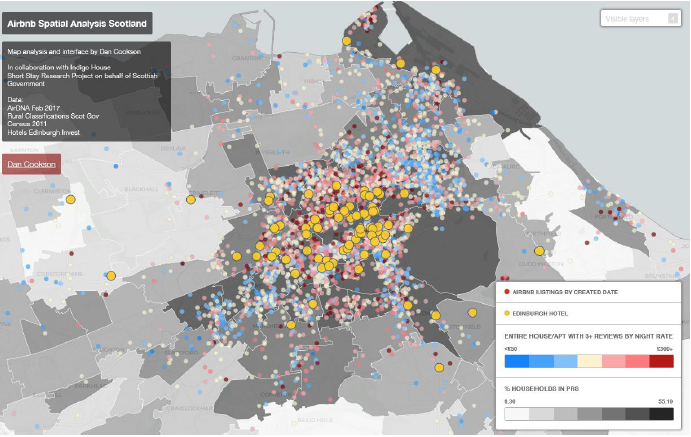
Source: Retrieved from Indigo House 2017, p. 22. Data sourced from AirDNA.
Indigo House, analysed AirDNA data and Scottish Government Housing statistics[16] to find that Airbnb entire home listings in February 2017 take up between 0.4% (in Glasgow) and 1.4% (in Edinburgh) of the private occupied stock (Indigo House 2017, p. 30). The corresponding figure for the Highlands was 1.2%. (Indigo House 2017, p. 30).
Characteristics of Airbnb Listings: Type, Availability and Multi-listings
Renting out for short periods or renting out a spare room while the owners/occupiers remain in the property can be considered amateur activity and can be differentiated from running a business, which is typically operated by professionals, and from renting out an entire home/apartment for long periods. This section studies:
- The type of accommodation offered by Airbnb listings (entire home or private room);
- The availability/occupancy of the listings (number of nights a listing is available to be booked/actual nights booked);
- Number of listings operated by each host (multi-listings, i.e. listings that belong to hosts who advertise more than one property).
Entire homes, booked for long time periods, and multi-listings might potentially have a negative impact on housing stock and local communities. Wachsmuth et al. (2017) define these listings as the 'triple threat' listings[17].
Type of Accommodation
Scotland
In Scotland in 2017, 59% Airbnb listings were entire homes and 40% were spare rooms (Table 6) (Airbnb 2017b).
Table 6 – Types of listing on Airbnb in Scotland
| Listing type | Share of listings (As of 1st July 2017) | Year on year growth (01/07/2014 -30/06/2015) | Year on year growth (01/07/2015 -30/06/2016) | Year on year growth (01/07/2016 -30/06/2017) |
|---|---|---|---|---|
| Entire Home | 59% | 78% | 94% | 55% |
| Spare Room | 40% | 85% | 80% | 43% |
| Shared Room | 1% | 294% | 64% | 6% |
Source: Retrieved from Airbnb 2017b, p. 4
Edinburgh
Similarly, in Edinburgh, the majority of Airbnb listings are for entire homes[18]. In July 2018, 61% (7,665) of the Airbnb listings in Edinburgh were entire homes/apartments; 39% (4,873) were private rooms; and 0.3% (40) shared rooms (Inside
Airbnb data 28 July 2018).
Table 7 shows an increase in the entire homes offered through Airbnb and, at the same time, a decrease in the renting out of private rooms.
Table 7 – Type of accommodation in Edinburgh, 2016-2018
| Type of accommodation | Jul-16 | Jul-17 | Jul-18 | |||
|---|---|---|---|---|---|---|
| Number | % | Number | % | Number | % | |
| Entire homes | 3432 | 54.7 | 5259 | 57.2 | 7665 | 60.9 |
| Private rooms | 2784 | 44.4 | 3881 | 42.2 | 4873 | 38.7 |
| Shared rooms | 56 | 0.9 | 49 | 0.5 | 40 | 0.3 |
| Total | 6272 | 100.0 | 9189 | 100.0 | 12578 | 100.0 |
Source: Inside Airbnb data
From the entire homes rented out through the Airbnb platform in 2018, 42% were 2-bedroom properties, 35.5% 1-bedroom properties, 13.3% 3-bedroom properties and 4.1% 4-bedroom properties (Inside Airbnb data November 2018).
Occupancy and Availability of Airbnb Listings
Scotland
Some cities, like Amsterdam, define short-term lets as listings available for 60 days or less. According to Airbnb reports, a typical listing in Scotland would operate for 40 nights annually in 2016/17 and 44 nights in 2017/18 or else between 3 and 3.8 nights per month (Airbnb 2017a, Airbnb 2018). In fact, slightly more than half of Airbnb listings in Scotland (54%) in 2016/17 were booked for under 30 nights/year (Table 8) (Airbnb 2017b). However, 28% of the listings in Scotland were booked for more than 60 days and 19% for more than 90 days. Similar patterns are displayed for Edinburgh and Glasgow.
Table 8 – Number of nights hosted on Airbnb listings, July 2016 – July 2017
| Number of nights hosted on Airbnb | Scotland % of all listings | Edinburgh % of all listings | Glasgow % of all listings |
|---|---|---|---|
| 1-30 | 54% | 53% | 49% |
| 31-60 | 18% | 17% | 15% |
| 61-90 | 9% | 9% | 10% |
| 91-120 | 6% | 5% | 7% |
| 121-180 | 7% | 7% | 9% |
| 181+ | 6% | 9% | 10% |
Source: Retrieved from Airbnb 2017b, p. 3
Edinburgh
In November 2018, Edinburgh Airbnb listings were rented out for an estimated 109 nights per year, with 29.9% of estimated occupancy (Inside Airbnb data 18 Nov. 2018[19]). Moreover, there were 6,155 listings (51.4%) with high availability (more than 60 days) and the remaining 5,830 (48.6%) with low availability (60 days or less). In September 2017, approximately 3,515 entire homes were rented out frequently, for an estimated 188 nights per year (Inside Airbnb data 18 Nov. 2018). In Edinburgh, entire homes were more likely than private rooms to be available for 60 days or more (Rae 2017, p. 2).
According to an Edinburgh City Council report (Edinburgh City Council 2018), just over 1 out of 5 Airbnb listings in 2017 were operating in excess of 90 days/year (data from July 2017). They argued that properties rented out for more than 90 days per year were highly likely to be operated in a commercial basis rather than a main place of residence (Edinburgh City Council 2018, p. 3).
Multi-listings
There are different types of participants in the collaborative economy (Scottish Government 2018a). In the peer-to-peer accommodation platforms, such as Airbnb, we find both occasional providers of tourist accommodation and professional operators. Professional hosts are more likely to be operating multiple listings compared to amateur hosts who are usually renting out a room or their main residence while they are away for short periods.
Scotland
According to a July 2017 Airbnb report, in Edinburgh, Glasgow, the Highlands, Fife, Argyll and Bute, the majority of hosts had one listing (78%) on the platform and a further 14% had two listings (Airbnb 2017b). Just 2% of all hosts had 5 or more listings (Table 9).
Table 9 – Number of hosts per number of listings in Scotland – in top 5 destinations* (as of 1st July 2017)
| Number of listings | % of hosts |
|---|---|
| 1 | 78% |
| 2 | 14% |
| 3 | 4% |
| 4 | 2% |
| 5 | 1% |
| 6+ | 1% |
Source: Retrieved from Airbnb 2017b, p. 6
* The top 5 destinations include Edinburgh, Glasgow, the Highlands, Fife, and Argyll and Bute.
Edinburgh
According to Inside Airbnb data for Edinburgh (Nov. 2018), 59.6% (7,142) of the listings were single listings, while the remaining 40.4% (4,843) were multi-listings. This pattern remains relatively stable during the period 2016-2018. Inside
Airbnb data suggests that, in September 2017, more than a third (2,030 of 5,474) of entire homes/apartments rented out through Airbnb in Edinburgh belonged to hosts with more than one entire home/apartment listing[20], who generated more than half of the revenue for this type of Airbnb listing[21]. Rae (2017, p. 2) highlighted that one host in Edinburgh had advertised 80 listings, while seven hosts had more than 20 and 28 hosts had 10 or more listings.
Airbnb Hosts
Scotland
Between March 2016 and March 2017 there were 12,600 hosts[22] in Scotland. (Airbnb 2017a).
In 2016/17, Airbnb hosts were on average 48 years old in Scotland, five years older than the average age in the UK (Airbnb 2017b). Based on the same report, more women operated as Airbnb hosts than men (62% and 38% respectively) and 32% of hosts were self-employed, while 29% were in full-time employment and 15% retired (Airbnb 2017b, p. 2).
The majority of hosts (76%) rented their primary or secondary homes and 41% relied on Airbnb income to make ends meet (Airbnb 2017a, p. 5). Hosts in Scotland earned[23] on average £3,600 per year (£68 million in total) in 2016/17 (Airbnb 2017a) and £3,800/yearly (£113.4 million in total) in 2017/18 (Airbnb 2018).
Edinburgh
Between March 2016 and March 2017 there were 5,400 hosts in Edinburgh (43% of the Scotland total) (Airbnb 2017a, p. 10). In Edinburgh a typical host earned on average £3,900 per year in 2016/17 (Frontline 2018, p. 9).
Airbnb Guests
Scotland
Between March 2016 and March 2017, there were 802,000 inbound Airbnb guests who stayed on average 2.8 nights in Scotland (Airbnb 2017a). More than half of these inbound Airbnb guests visited Edinburgh (411,000 guests – a 90% growth on previous year) (Airbnb 2017a, p. 10).
In 2016/17, just under half of guests (45%) arrived in Scotland between July and September, while 23% and 22% arrived between April-June and October-December respectively (Airbnb 2017b).
In 2016/17, the majority of the Airbnb guests chose Airbnb to "live like a local" (85%) and visited Scotland for vacation and leisure (87%) (Airbnb 2017a, p. 6). Just under half of the guest spending (47%) was done within the neighbourhood of the Airbnb property that they stayed (Airbnb 2017a). The estimated total spent by Airbnb guests in Scotland was £293 million (Airbnb 2017a).
Contact
Email: shorttermlets@gov.scot
There is a problem
Thanks for your feedback